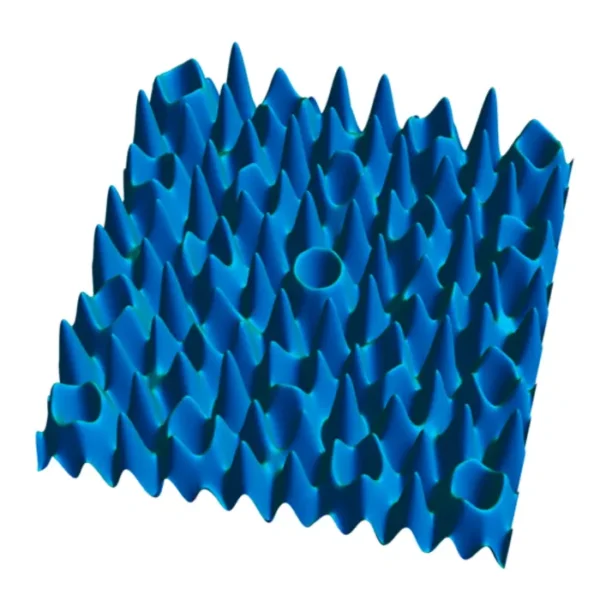Summary: Physicists at the University of Cambridge have created a two-dimensional Bose glass, a novel phase of matter that defies conventional statistical mechanics and could have implications for quantum computing.
Estimated reading time: 6 minutes
Researchers at the Cavendish Laboratory in Cambridge have achieved a significant breakthrough in quantum physics by creating the first two-dimensional version of a Bose glass. This new phase of matter, described in a study published in Nature, challenges our understanding of statistical mechanics and could pave the way for advances in quantum computing.
The Bose glass is a unique state of matter that exhibits glassy properties and particle localization. In this state, particles remain fixed in their positions, refusing to mix with their neighbors. Professor Ulrich Schneider, who led the study, explains this concept using a coffee analogy: “If coffee was localized, then when stirring milk into the coffee, the intricate pattern of black and white stripes would remain forever, instead of washing out to an average.”
Creating a New Phase of Matter
To create this novel phase, the research team used a combination of laser beams to generate a quasiperiodic pattern. Unlike a conventional crystal structure, this pattern is long-range ordered but not periodic, similar to a Penrose tiling. When ultracold atoms cooled to near absolute zero temperatures were introduced into this structure, they formed the Bose glass.
The significance of this achievement extends beyond the creation of a new phase of matter. Dr. Jr-Chiun Yu, the study’s first author, highlights its potential applications: “Such a material would offer many new possibilities, not only for fundamental studies, but also for building quantum computers, as quantum information stored in such a system should remain more local and not leak out into its environment – a process called ‘decoherence’ that plagues many current quantum computing platforms.”
Challenging Statistical Mechanics
One of the most intriguing aspects of the Bose glass is its apparent non-ergodicity. In simpler terms, this means that the system doesn’t “forget its details” over time, a property that defies conventional statistical mechanics. Professor Schneider explains the implications: “A big limitation of large quantum systems is that we can’t model them on a computer. To accurately describe the system, we have to consider all its particles and all their possible configurations, a number that grows very quickly. However, we now have a real-life 2D example which we can directly study and observe its dynamics and statistics.”
The Bose Glass-to-Superfluid Transition
The researchers observed a sharp phase transition from the Bose glass to a superfluid state, comparable to ice melting as temperature increases. Dr. Bo Song, a former postdoctoral researcher at Cambridge and now an Assistant Professor at Peking University, explains: “A superfluid is a fluid that flows without any resistance. Imagine particles swimming through a superfluid; there would be no friction, and the fluid would not slow them down.”
This transition between the Bose glass and superfluid states provides valuable insights into the behavior of bosons in interacting and disordered systems, which is described by the Bose-Hubbard model.
Why It Matters
The discovery of the two-dimensional Bose glass has significant implications for both fundamental physics and potential technological applications:
- It provides a real-world system for studying complex quantum phenomena that are difficult or impossible to simulate on classical computers.
- The localization properties of the Bose glass could lead to improved quantum information storage, potentially enhancing the performance of quantum computers.
- It offers a new platform for investigating many-body localization and non-ergodic systems, which are at the forefront of quantum statistical physics research.
- The study of Bose glasses could lead to a better understanding of disordered systems in general, with potential applications in materials science and condensed matter physics.
Looking Ahead
While the discovery of the two-dimensional Bose glass opens up exciting possibilities, Professor Schneider emphasizes the need for further research: “There are many things we still don’t understand about the Bose glass and its potential connection to many-body localisation, both regarding their thermodynamics as well as dynamical properties. We should first focus on answering more of these questions before we try to find uses for it.”
As researchers continue to explore the properties and potential applications of the Bose glass, this new phase of matter could play a crucial role in advancing our understanding of quantum systems and developing new technologies based on quantum principles.
Quiz:
- What unique property does the Bose glass exhibit that challenges conventional statistical mechanics?
- How did the researchers create the two-dimensional Bose glass?
- What potential application of the Bose glass in quantum computing did the researchers highlight?
Answer Key:
- The Bose glass exhibits non-ergodicity, meaning it doesn’t “forget its details” over time.
- The researchers used a combination of laser beams to create a quasiperiodic pattern and filled it with ultracold atoms cooled to near absolute zero temperatures.
- The localization properties of the Bose glass could help reduce decoherence in quantum computers, potentially improving quantum information storage.


